

Noyhauser
-
Posts
1581 -
Joined
-
Last visited
Content Type
Profiles
Forums
Events
Gallery
Posts posted by Noyhauser
-
-
I'd actually suggest something different. Bandai has re-released some imai or arii kits from back in the day at extremely reasonable prices: 1/100 versions for 800 yen and 1/72 at 1200ish. None of them are bad models by any means... they just require some TLC. I think with a bit of basic scratching and painting (something I suspect you're probably good at) you should be able to put together something awesome. And at that price you can do two 1/100s at the same price as a wave. OR get one of each. Its what a lot of us recommend as a beginner kit before the hasegawa ones.
-
Well, this one will be different in several ways. Painting will be required. basic gluing and construction skills as well. Its actually possible to build the kit (certain versions) with very little paint... but that's actually a bit of a master skill build. So... yeah, painting will be required. However for basic versions, you can almost get away with only one coat of white (or caramel for Cannon fodder) and some basic weathering skills.
-
Easily, but your best bet is to remove the decal if you can, or respray the base color over it. Microscale offers several solutions (the blue or red one) in the little bottles that would help removing the decal. Several applications and you should be able to remove it, then reapply the white decal. Hot water works well too, you just need to be careful if you've got a gloss coat underneath.
-
If you live somewhere near/ in Japan, I recommend it and Wonder Festival. I see many non-Japanese guests at the venue.
In Shizuoka, I found some Caucasians sitting on the chair. They are members of the amateur modelers' clubs.
I remember one of their names. "Sirius." I googled, and it seems it is the modelers' club in Kyoto.
http://gosuke.blogzine.jp/sirius2012/bbs.html
A poster's name in the BBS is apparently non-Japanese, and many foreign students are in Kyoto, as you know.
If you live somewhere near/ in Japan, I recommend it and Wonder Festival. I see many non-Japanese guests at the venue.
In Shizuoka, I found some Caucasians sitting on the chair. They are members of the amateur modelers' clubs.
I remember one of their names. "Sirius." I googled, and it seems it is the modelers' club in Kyoto.
http://gosuke.blogzine.jp/sirius2012/bbs.html
A poster's name in the BBS is apparently non-Japanese, and many foreign students are in Kyoto, as you know.
That's awesome! Thank you. I do stay alot in Kyoto but we're from the Kii peninsula, which makes travel a bit difficult. I'll definitely hit them up when I come next.
-
Even their "fixed with stolen designs" 1/32 Flanker has issues after revising, I can't imagine they did that well on their 1/72. Trumpeter is the king of "totally awful intake and canopy shapes despite copious reference". Their 1/32 F-14 is the worst F-14 money can buy, despite being the newest/biggest one around. It looks like a swing-wing F-15...
Well, they actually put out a pretty good kit in the 1/72 range. I'll just point you to this thread at ARC; Flankerman generally knows his stuff (I think he's built every version possible of the flanker).
That's not to say that the Hasegawa version is "bad." Both are considered very good models (of different types of flankers).
-
antibiotictab:
Pretty awesome... thank you for this. I wanted to go this year but I couldn't. Maybe next year.I've been thinking about different schemes I built a Black and white VF-1D scheme, but never photographed it. Now I'm trying to decide what I'm going to do with my Spartan.
-
Checkmate: please post them! please please please! I'm always interested in how others build their models.... you can always learn something new.
-
Not sure about acrylic lacquers being non-yellowing as I assume any paint will eventually yellow/discolor with time, unless if maybe stored in a dark temperature controlled room.
You might want to give Mr.Color's UV clear coat, this will at least slow down the yellowing/dibs coloring process. I have kits displayed for three four years now without any problem.
I was just about to say the UV clear coat helps. make that +1.
-
Hello, I'm new to the Hasegawa model kits first time touching one (VF 1s/a/j 1/72 valkyrie) and realised how different it is. I had a look at the basic guide but I have a few more question.
Do you have to use super glue to put the pieces together?
The basic guide said to wash it with soapy water, I tried that but the feeling of it felt the same. Does it make a huge difference?
Are all the steps from filling gaps, sanding and engraving really neccessary for the model to look decent?
Thanks for your help.
Hey. First off, you've picked up a great kit. Its one of my favorite ones ever. However its not exactly an "easy" kit. Its fiddly at parts, and requires a bit of skill. But it really rewards the effort.
Petar B has given you some good pointers, but let me elaborate a bit. You can use super glue, but for the best results, try to find some plastic model cement and a good one; I really like Tamiya, which can be found in most local hobby stores. What they do is bind plastic together by melting it. when you glue it together it creates a really great bond and reduces the chances of a seam line forming. Its a bit of a balance between too much and too little, but its much better than Cyanoacrylate (CA or superglue). Its also good practice to use a clothes pin to hold together parts while they set. Now there is a use for CA; it can serve as a gap filler if applied in a gap.
Other options are as petar B stated are miliput, various putties (Tamiya's good as is aves and others, but stay away from the testors stuff). Sanding really helps though... especially if there is a seamline or some other depression. Engraving isn't really necessary, unless you remove some lines and want to replace them
-
Most likely, yes, it should work. Another trick is to test. I've got a lot of scrap models or big plastic pieces (old CD Cases primed with Mr Surfacer in my case) to try out different things if needed. This would be a good opportunity to do that.
-
hmmmm I don't have an answer for that... I've never tried it (If its mineral spirits I keep that stuff for washes because of its cost.) Thinking about it, maybe not, since it doesn't react to the gloss coat underneath (Which is why I use it for a sludgewash. Again that is if its mineral spirits I'm not sure.
-
Arise Thread!
So I bought a Bandai 1/72 Spartan for 800 yen (it was a choice between it and the Regult which were both on sale). Pretty awesome price... does anybody have any links for very good buildups (besides the model graphics one in this thread)? I'd like to do some extra detailing and would love some ideas (especially on how to improve the legs)
-
I don't think future itself has ammonia (though I could be wrong.) I don't use windex to thin anymore either since I went to heavy misting. It can be cleaned with alcohol too. Future is pretty versatile which is why it was favored for so long
Aquagloss is acrylic as well AFAIK.
-
Dang, I'm not generally one for "fake" model planes, but I would buy Yellow 13... (if I could get one pre-painted, I suck at camo---and little white fins on missiles)
Hase's new Su-33 is probably about the most accurate Flanker model out there.
PS---surely it comes with alternate markings for Yellow 4?
As you can imagine this has been a point of contention among aficionados. Some say that the spine looks off and point out other issues. There is quite a bit of love for the 72 trump kits. Frankly I think it looks very good too, except for that price.
also, second best kit announcement to go with it:

 :wub:
:wub: 
OMG its finally here. This kit has been a huge piece of vaporware for the past three years. Hasegawa had hinted they were going to do it, particularly after the problems with the Fujimi kit.
Edit: Oh wait. its just another revell rebox isn't it? Way to get my hopes up hasegawa.
-
I wish Hasegawa would repop the crap out of the Battroids. The Bandai kit also looks too SMALL. Its 1/72 in name but it seems smaller than that to me. Especially the picture with the hand behind it. Their VF-25 kit suffers from the same smaller than 1/72 scale feeling. The pilot in that is TINY. Gimme a Hasegawa battroid any day now...
Is this going to become another tiny hands vader flamewar?
I kid.
Seriously though, I have to wonder how well the battroids have sold when my japanese LHS has quite a few of them still in stock.
-
@Noyhauser: You mentioned cutting Future with Tamiya matte. Can I still hand-brush it onto the model like unmixed Future? I've heard unconfirmed comments that the Tamiya matte might mess with Future's self-leveling properties.
I do have an airbrush, but it's a very basic single-action one with non-adjustable air pressure, so AB'ing Future might be too difficult with such equipment. Besides, I don't want to risk having any of it drying inside the AB.
BTW, those are some very beautifully built planes!
Hmm... I've never tried applying it by hand brushing. If there is a problem, this is one approach I can suggest you try off the top of my head. I used to thin future with windex to retard its drying because I got pebbling with the AB. I later figured out how to avoid that issue so I stopped using windex. I suspect that Windex + future + tamiya matte might alleviate any possible issues with hand brushing. The other option is to do multiple thin coats, though that can be tougher.
As for Air Brushing Future, its not as tough as it seems, even with a single action. Probably the "Eureka" moment for me was when I pulled the airbrush away from the model about a foot or more that what I normally paint it with... the best way I can describe the situation is that you're hitting the model with a heavy mist rather than a spray. After about two or three applications spread five to ten minutes apart (or even four or more) you should have a nice, consistent coverage. Also don't be afraid to do one side only, then do the other later. This approach is much more forgiving as well, since the rate of application is actually kinda low. IT shouldn't be that hard with a single action... especially if you clean the AB after. (also remember that Future is pretty easy to attack with a whole host of cleaners, from windex to lacquer thinner.
I also touch up areas with a clean brush (I have one that I only use for this) dipped in microscale decal setter (or softener... the one with the red lettering). Future often just does what it wants, with areas that unexpectedly accumulate, so this allows you to move around dry or drying future.
There are other products as well that are just as good. A new one is Alclad aqua gloss, which goes on with really easy consistently. I've heard people discuss the xtradecal stuff in good terms. Its really finding what is good for you. I've tended to stay with future because it can go on a bit thicker, which helps to mask decal carrier film better, which is a bit of a pet peeve of mine.
-
Painting-
Lacquer, use whatever you want! I myself use Mr. Color pretty much exclusively, and that is a lacquer based paint. Doing the old-style wash, I'd use a very diluted flat black enamel. Did no harm to the original paint job.
A minor quibble: Mr Color isn't actually a lacquer... its a solvent based acrylic. It uses a lacquer based thinner, but the paint itself is acrylic. Lacquer paints use a different binding method to acrylic... or so its been explained to me.
Regardless, I love the stuff. I used to use tamiya and now I only by Gunze.
-
Personally I was wondering about gloss vs semi-gloss vs matte.
Non gloss paint has a microscopic texture that messes with decals?
And metallic paint does not look good over matte, so if you want it to be matte, paint a high gloss, paint the metallic, then clear coat matte over it?
Metallics over matte paint isn't necessarily a bad thing, provided its a fine matte, not a very rough one. What it does is create a matte texture for the metal... which in some cases is okay like if there is excessive wear. For the most part however, it isn't as most aircraft are not beaten up in this way. As I note above, you can actually get a better effect by using a bit thicker oil wash, and leaving a bit on at the end. That gives you a more realistic matte look for certain circumstances. A variation for me for this is: Primer-alclad-decal-gloss-oil. In other cases, primer-alclad-decal-gloss-matte, works fine as well.
-
One of the biggest pieces of advice I can give is do your research. If its a real life aircraft, find photos and note what you see. I'll give an example. A few years ago a friend gave me a tub of documents on his grandfather's war service. I'm trying to model every aircraft he flew. This is probably one of my favorites:

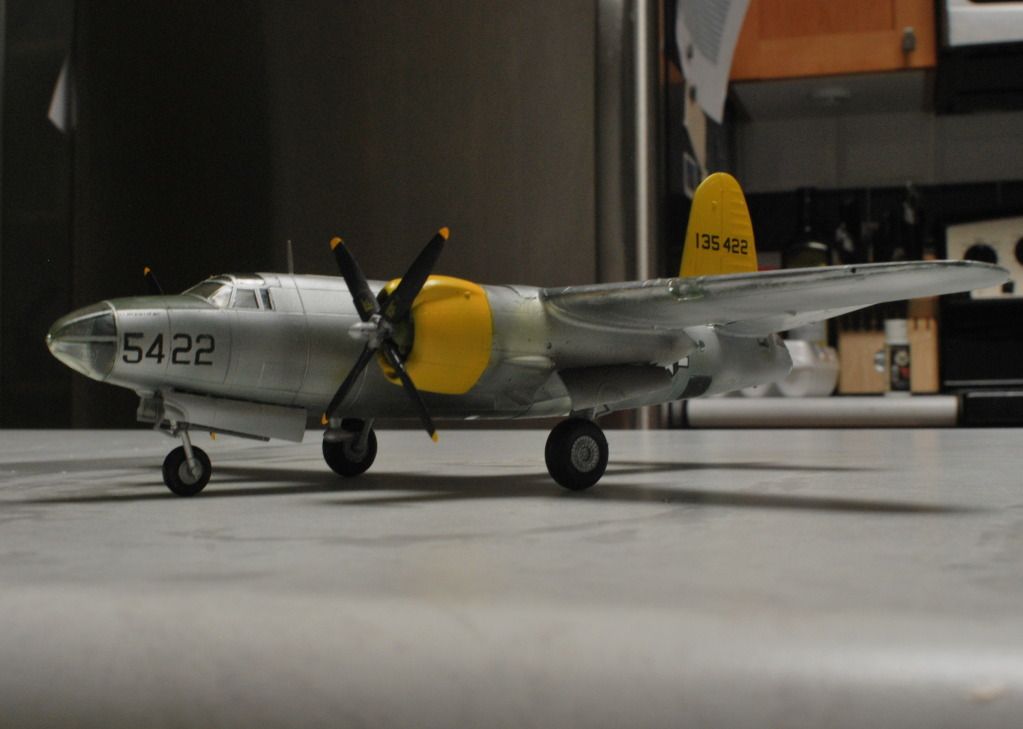
It wasn't a final model... looking at the photo I quickly noticed that my landing gear was backwards. I could have done better with doing different variations in colour on the fuselage too (its not as uniform on the RL aircraft.) A lot of modellers start collecting reference material. I know HWR on the board keeps photos of different scratching and effects on tank hulls so he can model them. I photograph and collect photos of planes in colour to get a sense of what they looked like in different stages of wear.
Also, let me post a little guide to different effects you can have with Alclad, which is a common natural metal finish paint more advanced modellers use. Its difficult, but probably provides the best range of effects.
I've tried quite a few different approaches to NMF... these are organized chronologically, so it kinda shows the learning process I went through.Plain Primer + gloss coat + medium oil wash.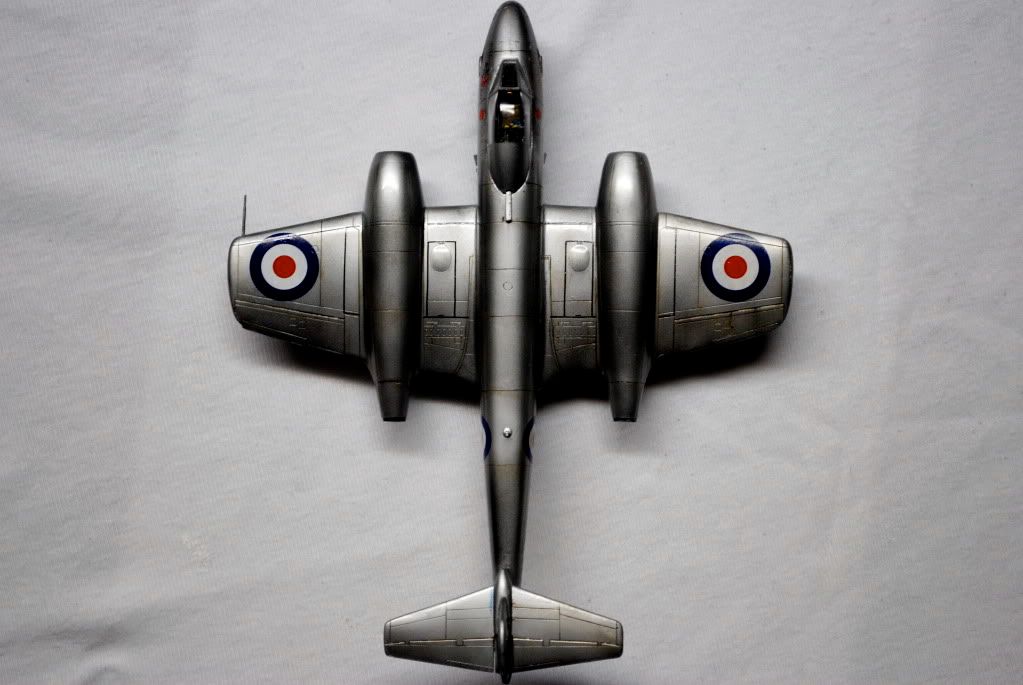 First attempt at masking (standard on almost all subsequent models)
First attempt at masking (standard on almost all subsequent models)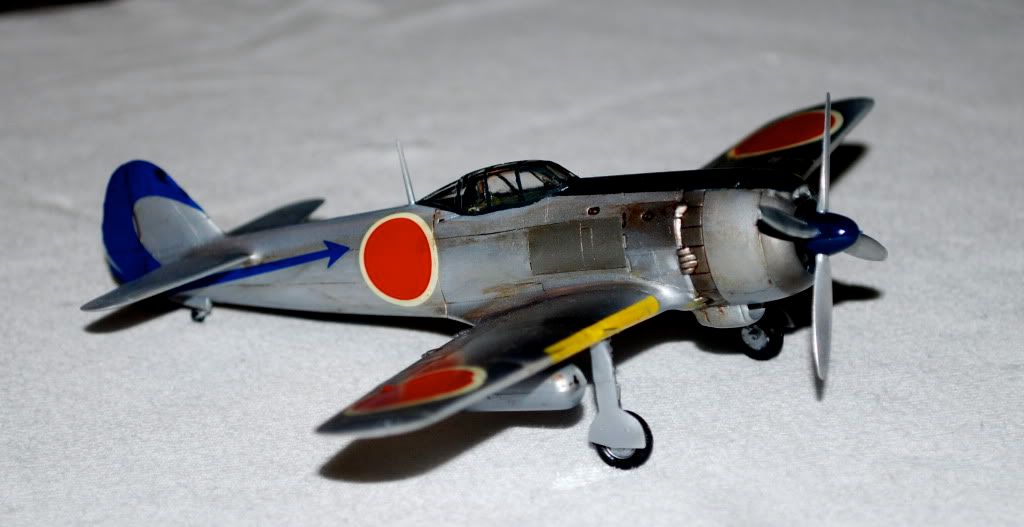 Alclad Buffing + Gloss coat + light Oil wash.
Alclad Buffing + Gloss coat + light Oil wash.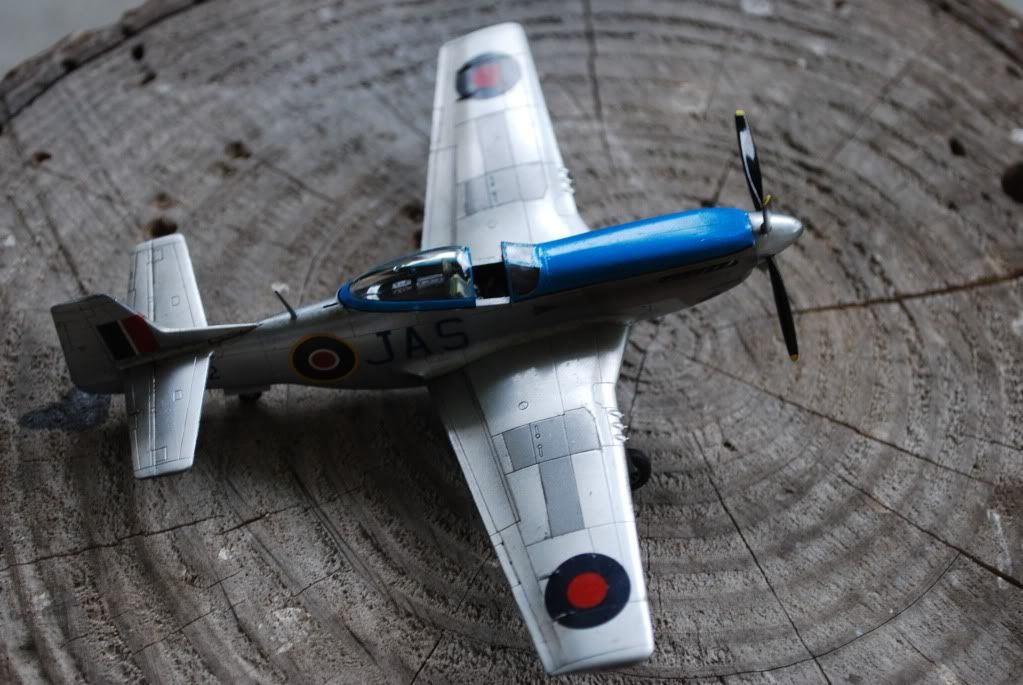 Alclad + Rub&Buff (on wing-walks) + light oil wash.
Alclad + Rub&Buff (on wing-walks) + light oil wash. Probably the best finish I've had for a shinier model...Alclad primer + Alclad + light Oil wash/streaks +Future cut with Tamiya matte.
Probably the best finish I've had for a shinier model...Alclad primer + Alclad + light Oil wash/streaks +Future cut with Tamiya matte.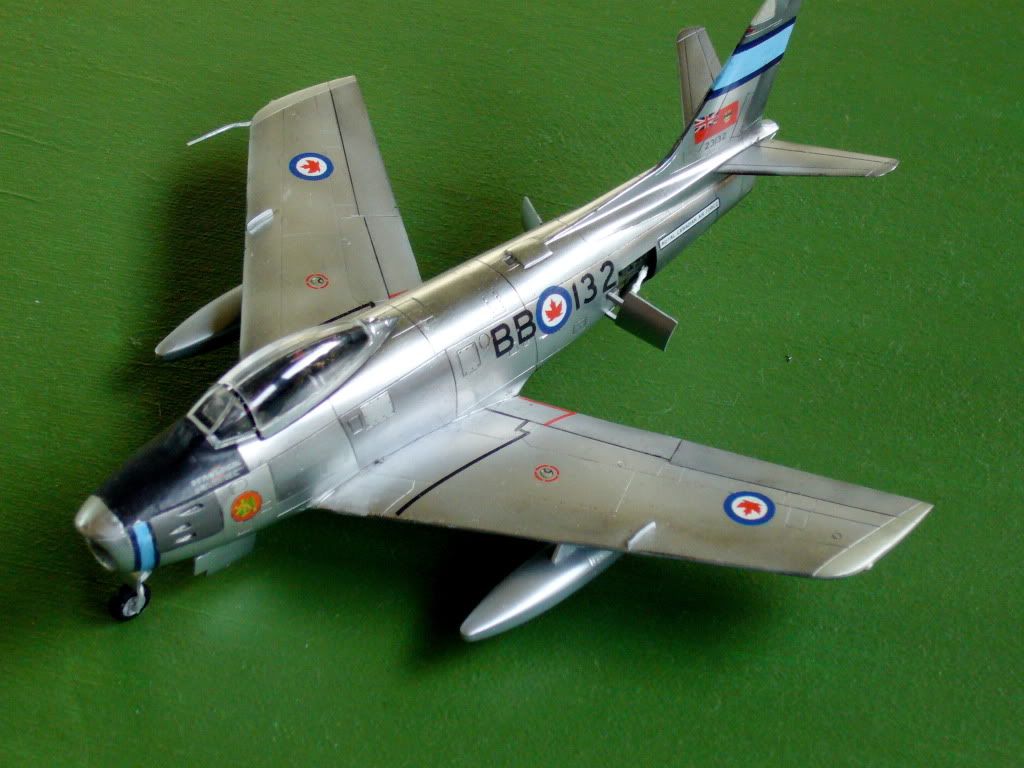 heavy streaking and mottled effectAlclad + glosscoat + heavy oil wash
heavy streaking and mottled effectAlclad + glosscoat + heavy oil wash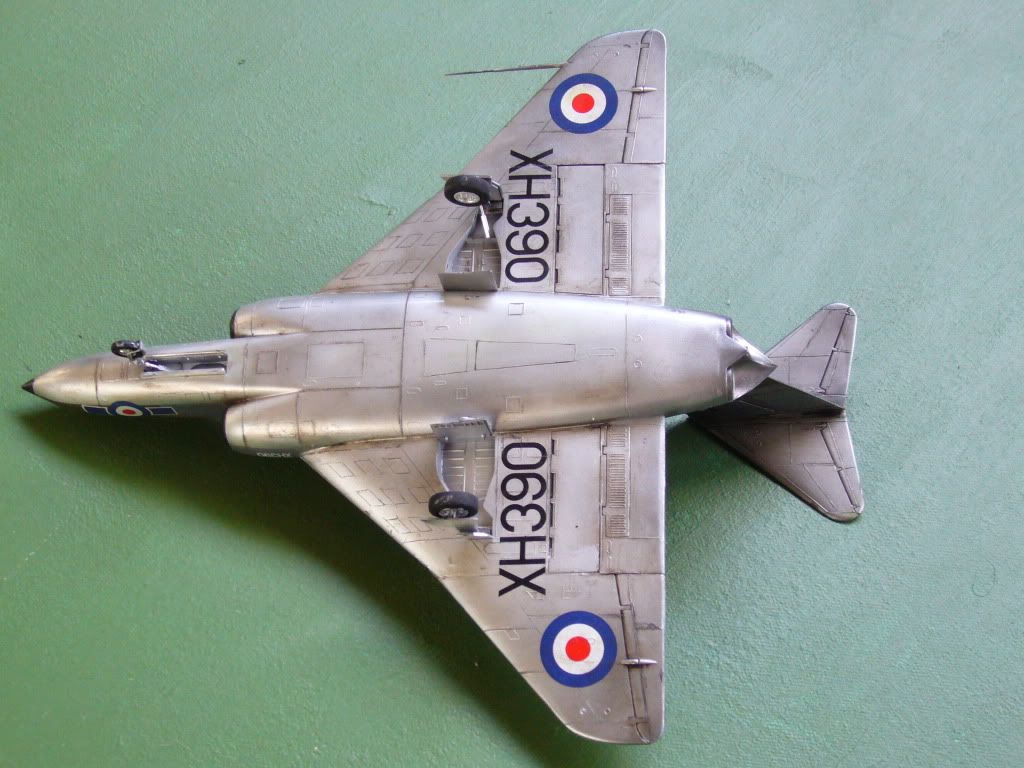 Best finish I had with a matte BMFAlclad + light oil wash/streaks + post shading + matte coat
Best finish I had with a matte BMFAlclad + light oil wash/streaks + post shading + matte coat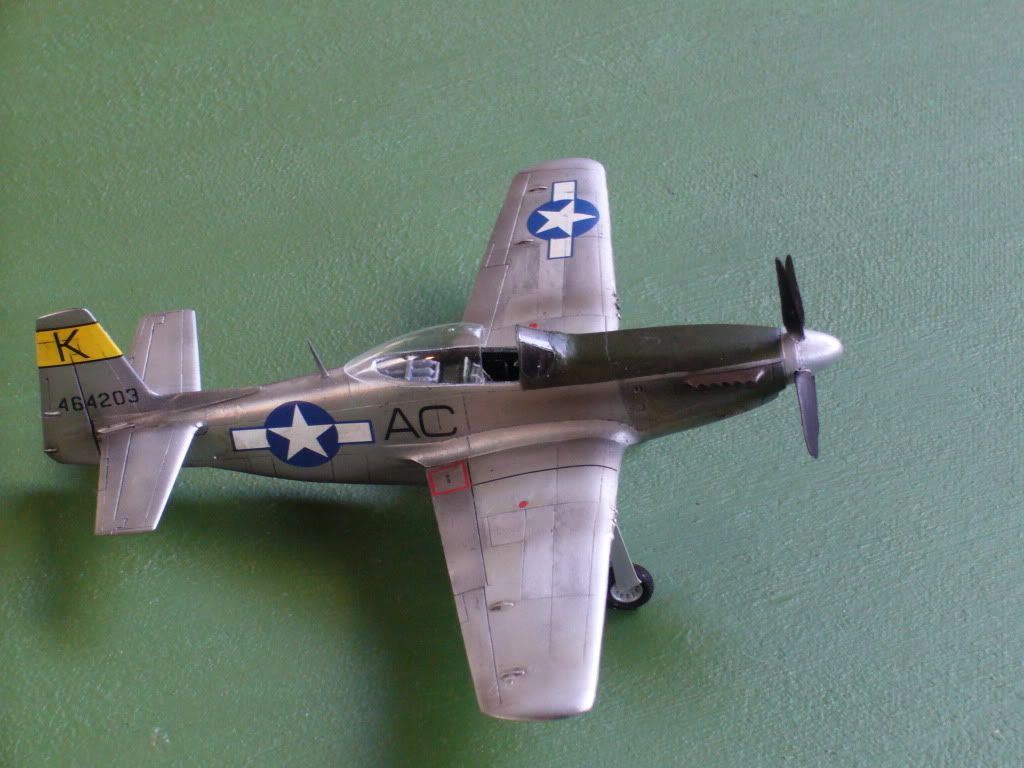 One other one I've started using since I posted this is a different primer colours, and a form of preshading. Basically the deep green give the subsequent aluminum a different hue... which is a bit more realistic than straight black. you then don't completely fill in the entire airplane, just the main areas of the panels; the panel lines are left a little underpainted so that the primer shows through... barely. It gives a more weathered effect without having to use heavy panel lining.
One other one I've started using since I posted this is a different primer colours, and a form of preshading. Basically the deep green give the subsequent aluminum a different hue... which is a bit more realistic than straight black. you then don't completely fill in the entire airplane, just the main areas of the panels; the panel lines are left a little underpainted so that the primer shows through... barely. It gives a more weathered effect without having to use heavy panel lining.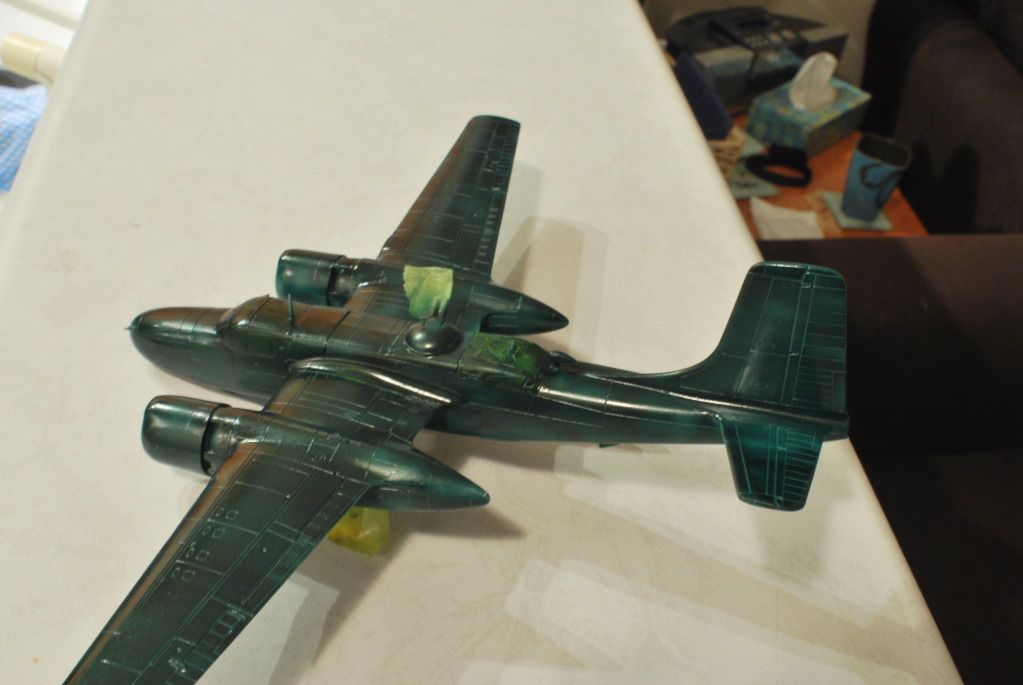
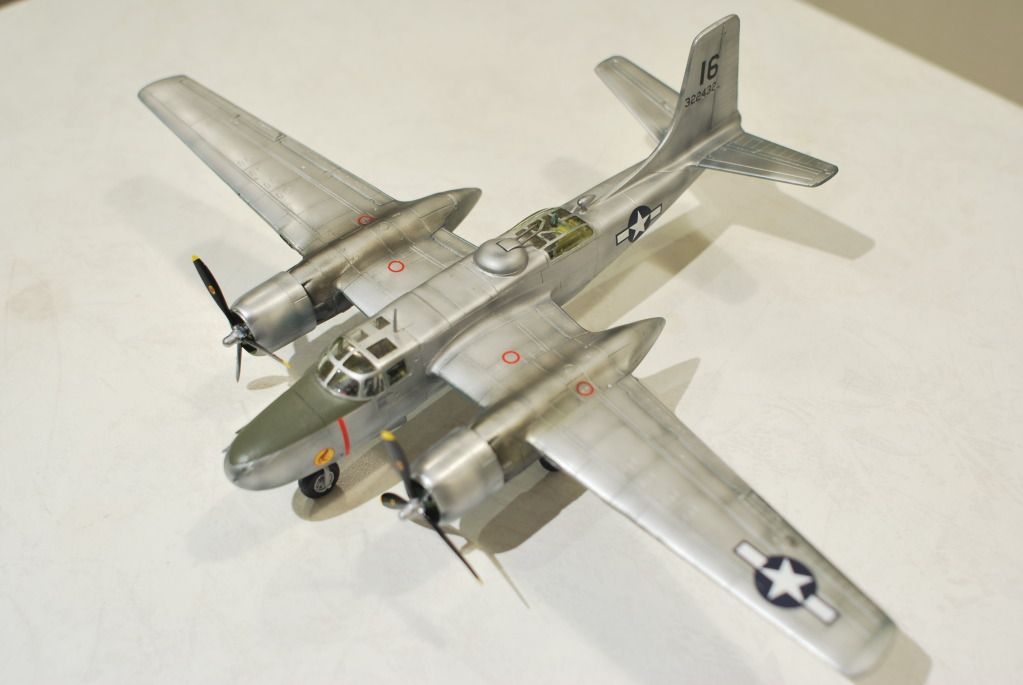 Hope that helps!
Hope that helps! -
Great thread... I've got a few.
Tin foil makes an excellent masking material for large areas. While you obviously still have to mask the edges, you can simply wrap tin foil around a large area you don't want to get paint on, instead of disassembling the whole figure. It's pliable but retains its shape, making it perfect for the job. It's also cheaper than Tamiya tape, saves time and effort, and doesn't leave any glue residue, not to mention that there's no risk of lifting the paint when you remove it.
I've been using it during paint sessions for a FOC Jazz repaint; it was a great help, as unlike model kits, there are quite a few parts you just can't separate in a TF.
Just fold in the edges so they don't scratch the newly-painted area when removing the foil.
A different approach that works for some aircraft models is to actually photocopy the instruction sheet to the correct size, then cut out the various colours. IT really works well with ones that are flat in planform rather than one that curves alot. The VF-1 would be a good example of a generally flatter planform... something like an typical airliner (747) is probably not the best because of its tube fuselage... though you;ll usually get the wings done through this method. You'll need to correct for where the aircraft shape changes. Alot of instructions will clearly say what percentange it is reduced by, thereby making it easy to identify what you need to do. you just tape on the mask you've cut out, and volia; super cheap and easy mask.
left over sprue is also useful in a couple of different ways:
1) I use it as a source for solid styrene rods - comes in handy very often! (I mod a lot of kits!)
2) It can also be used to make your own styrene filler/putty. Just leave it in a close container of Ambroid or Tennax.
Granted both of these a slightly more 'advanced' uses, but I thought it was worth mentioning here.
Also an awesome source of stretched sprue (heated up over a flame and pulled apart) which is what I make all of my aerials, pipes, fuel lines ect on aircraft.
-
Finished my 1/720 Bug Eye Scout. Tried every trick I know to get the 30+ year old decals to come off the sheet but had no luck so I'm going with this is as it looks more anime accurate! Pretty proud of this turning out as well as it did considering the 30 year old cheap dime store plastic! There were more than a couple of unplanned breaks....enjoy!
Awesome work... very clean and well executed.
One question/comment. Are you still able to rotate the actual model? I was recently reading a book by master Diorama builder Shep Paine and I found this recommendation:
NEVER PUT ANYTHING PARALLEL TO THE EDGE OF THE BASE. (his exclamation, not mine).
-
I get the feeling I'm the only non-Japanese Macross fan who actually likes this kit. Here's a thought: It's Macross gunpla, not a high-detail rigid kit. You lose detail and screen accuracy to accommodate gimmicks like no-swap transformation and poseability. I'll admit I don't think it's perfect, but it's pretty good for not being Bandai's main IP.
I never thought I'd see people in such an uproar over a re-take on a model kit of a fictional transforming robot plane. The neckbeard is strong with this thread.
My care level for this is pretty low to start and I suspect its the same for a lot of the more dedicated modellers on here. The outcome is an even bigger meh. There was a a very low chance I would buy this model, unless they pulled something amazing here... and they certainly didn't do that (yet).
-
Serious question: if this was a super expensive, limited run resin kit from someone like Experten, would you guys have the same level of hate-on for this?
I think it's a cool alternative take on something that's been done a million times in a million different ways already.
Personally, I'm not really one to care for transformables. I'm really an old school model builder: I build WWII props, modern jets and ships... all in a specific scale (1/72 or 1/700.) Once completed I don't touch them again. So the "gimmick" of transformation doesn't interest me. As such, its closer to a toy in my view (but not a toy... its a gunpla)
Don't get me wrong... I think they are very cool and show unbelievable levels of skill. However its just not for me.
-
I really insist, why most of you compare these to Yamato, these is a "model kit"not a toy. BTW these Bandai looks really bad.
Because a lot of us don't consider this a true model kit. View it more like a gunpla... or gundam model. Its certainly aimed at a more casual market segment than hasegawa... to me its somwhere between Yamato and Hasegawa (particularly given Yamato offering more options for customizations.)
New to Hasegawa Model
in The Workshop!
Posted
Well its kinda being discussed in the thread pinned at the top. Not using hot water isn't really a terrible thing either. Its just a little difficult to get the decal off the page then onto the model and adhere. If you have decal softener or setting solution it really makes a lot of difference to get the decal set onto the surface and adhering nicely. And if its already on the surface and adhering nicely, then you have nothing to worry about!